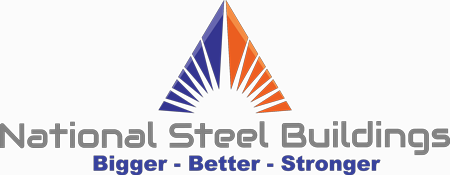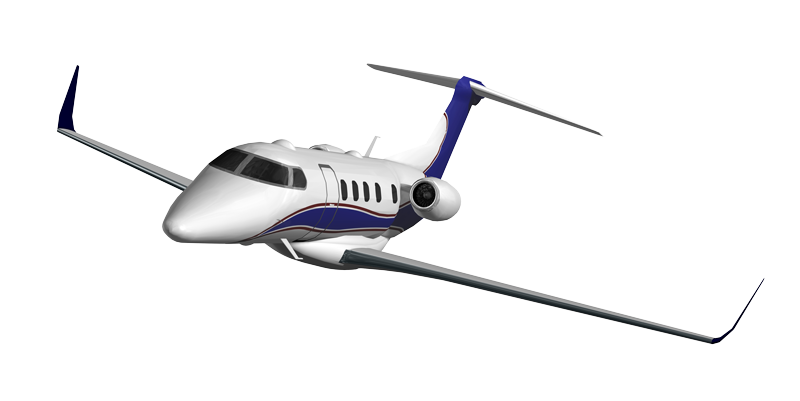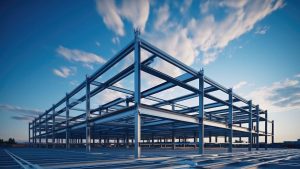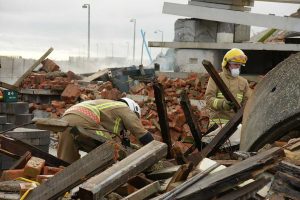Steel buildings have many benefits with regard to industrial construction. Despite this, however, there are two primary types of steel building ‒ and they each serve their own purpose. In this post, we will be going over the unique properties, as well as differences between Portal Frame Steel Building, and the less-known Arched Frame Steel Building.
PORTAL FRAME STEEL BUILDING
What is a portal frame steel building?
Portal frame steel buildings, also known as straight-wall buildings, are a type of steel building commonly used for industrial and commercial purposes. They are made up of a series of columns and beams that support the roof and walls of the structure, creating a strong and stable building. In fact, approximately 50% of commercial steel in the UK goes towards portal frame construction.
Portal frame steel buildings typically consist of straight walls, which provide a strong foundation for the building, as well as longitudinal bracing, which offers sound internal resistance. Brackets, also known as haunches, are used to increase the stability of the building, while rafters create a pitched roof. The beams and frames of the structure take up some space inside the building, which can limit the amount of usable space and make it more difficult to store or manoeuvre large objects within the building.
Advantages of portal frames
One of the main advantages of portal frame steel buildings is their robust columns which support the entire structure. The main framework of these buildings is comprised of straight walls, which provide a strong foundation for the building, as well as longitudinal bracing, which offers sound internal resistance. Brackets, also known as haunches, are used to increase the stability of the building, while rafters create a pitched roof.
Another advantage of portal frame steel buildings is that they often come equipped with a guttering system that helps filter out water, especially on rainy days. However, it is important to note that these ducts will need regular cleaning to avoid excess clogging.
Potential drawbacks
One potential drawback of portal frame steel buildings is that the beams and frames take up some space inside the building. This can limit the amount of usable space and make it more difficult to store or manoeuvre large objects within the building.
Portal frame steel buildings are typically limited in height due to the need for bracing and stability. This can be a drawback for projects that require a lot of vertical space or that need to accommodate tall machinery or equipment.
ARCHED FRAME STEEL BUILDING
What are arched framed buildings
Arched frame steel buildings, also known as Quonset huts, are a relatively new design that is becoming increasingly popular in the industrial construction sector. These buildings are based on military shacks used in the 1940s during World War II and were designed to be easy and quick to build while still being cost-effective. They are made up of a series of arched steel panels that are bolted together to create a strong and stable structure.
Arched-frame steel buildings are constructed using fewer parts than portal-frame buildings. They are basically layered sheets of steel that are bent to form appealing configurations. The simplicity of this design means that arched frame buildings can be constructed quickly and efficiently, making them a great option for projects with tight deadlines.
Advantages of arched frames
One of the main advantages of arched-frame steel buildings is their efficiency in terms of space utilisation. These buildings are built to fortify themselves efficiently, making them more reliable than their portal frame counterparts. Additionally, arched frame buildings employ a slanted roof for water runoff, which eliminates the need for a guttering system.
Arched-frame steel buildings are also highly customizable. They can be designed to accommodate a variety of different layouts, sizes, and shapes, depending on the specific needs of the project. They are also compatible with a wide range of cladding and roofing materials, allowing them to be customized to suit a variety of aesthetic and functional requirements.
Another advantage of arched-frame steel buildings is their durability. The layered steel sheets used in their construction create a strong and sturdy structure that can withstand harsh weather conditions and natural disasters. Finally, arched frame buildings are also aesthetically pleasing, with their curved design adding a unique visual element to any industrial space.
Potential Drawbacks
The curved shape of arched-frame steel buildings can make it more difficult to install windows and doors in certain locations. This can be a drawback for projects that require a lot of natural light or that need to accommodate specific entry and exit points.
The curved shape of arched frame steel buildings can also limit headroom in certain areas of the building. This can be a drawback for projects that require a lot of vertical space or that need to accommodate tall machinery or equipment.
Conclusion
In conclusion, both portal frame steel buildings and arched frame steel buildings offer unique advantages and potential drawbacks that must be carefully considered when choosing the right building solution for a specific project.
Portal frame steel buildings are a more traditional and widely used type of steel building, known for their simplicity and efficiency, while arched frame steel buildings are a newer design that offers a unique curved shape and greater space utilization efficiency.
Ultimately, the choice between these two types of steel buildings will depend on the specific needs and requirements of the project, as well as the available budget and timeline. Regardless of the choice, steel buildings remain a popular and practical choice for industrial and commercial construction projects, offering durability, strength, and customization options that are difficult to match with other building materials.
If you are ready to begin your steel building project, National Steel Buildings is here to help you. We cover the entirety of the UK so give us a call today to discuss further.




